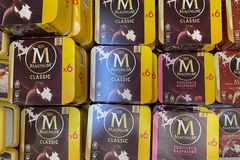
- Industry news
Industry news
- Category news
Category news
- Reports
- Key trends
- Multimedia
- Journal
- Events
- Suppliers
- Home
- Industry news
Industry news
- Category news
Category news
- Reports
- Key trends
- Multimedia
- Events
- Suppliers
Barry Callebaut Prepare for Probiotic Chocolate Launch

Special production process guarantees very effective probiotics in the end chocolate Probiotics are widely thought to aid in restoring the balance of the intestinal flora, providing protection against infection while improving metabolism.

26/10/07 Next week will see the launch of the world’s first probiotic chocolate produced on industrial scale at the Food Ingredients Europe 2007 trade fair in London. Barry Callebaut’s latest innovation in the field of functional chocolate is the outcome of intense cooperation between the chocolate manufacturer and the Lallemand group, producer of probiotics.
Thanks to a number of revolutionary modifications to the chocolate-making process, Barry Callebaut has succeeded in producing a chocolate enriched with probiotic microorganisms that help to restore the balance of the intestinal flora, capable of resisting the normal chocolate production process with a long shelf life. Initial studies also confirm that chocolate is a superior carrier for the intestinal delivery of probiotics, ensuring the survival of up to 4 times as many beneficial probiotic bacteria as those contained in milk-based substrates.
Special production process guarantees very effective probiotics in the end chocolate Probiotics are widely thought to aid in restoring the balance of the intestinal flora, providing protection against infection while improving metabolism. The challenge is to ensure the survival and activity of the orally ingested microorganisms within the harsh environment of the human digestive tract.
Hans Vriens, Chief Innovation Officer at Barry Callebaut explains: “Ensuring the sufficient distribution of the probiotic micro-organisms in chocolate on an industrial scale is no easy task. High temperatures and pressures can have a negative influence on cell-counts of the integrated probiotic strains. We therefore developed a production system that guarantees a homogeneous blend of the probiotics in the chocolate, within a restricted temperature range, and we have succeeded in developing a special process which guarantees the survival of probiotics in the chocolate matrix.”
Research shows significantly higher survival rates of probiotics in chocolate Initial tests conducted by Barry Callebaut on the viability of probiotic chocolate have already generated remarkable results. When subjected to in vitro simulations of the human stomach and small intestine, chocolate-embedded probiotics were shown to have significantly higher survival rates than those in milk-based carriers. In fact, the probiotics delivered in chocolate suffered virtually no negative effects from stomach acids while the milk-based probiotics had end-counts 4 times lower than the original mixture. Ongoing tests reveal that chocolate may be an ideal carrier for the intestinal delivery of probiotics with positive effects observed on the balance of the microflora of the large intestine: the probiotics added in the chocolate reach and colonize the large intestine, thereby also enhancing the growth of other Lactobacilli and Bifidobacteria.
Thanks to the significantly higher survival rates of chocolate-embedded probiotics, daily consumption of just 13.5g of probiotic chocolate is sufficient to ensure optimal activity on the intestinal microflora. Best of all, the probiotic supplements have absolutely no influence on the renowned taste, texture and mouth feel of Barry Callebaut’s widely acclaimed chocolate. Barry Callebaut also offers to share the proprietary pre-clinical data on survival rates and probiotic activity in chocolate with potential customers.
Result of extensive cooperation with functional food unit of Lallemand Barry Callebaut’s unique probiotic chocolate uses the synergy effect of two specific bacteria strains well adapted to chocolate and a micro-encapsulation technology developed by Lal’food.
Bruno Delattre, Business Director at Lal’food explains: “The patented Probiocap technology involves applying a protective shield around the probiotic bacteria, ensuring their survival in the digestive tract and thus optimal activity in the gut, their site of action. Probiocap also provides an answer to several known stability issues of probiotics in non-dairy applications. Probiocap thus enhances the viability and resistance of probiotics to heat, compression and high gastric acidity.”
“We are very pleased that the results of this cooperative project have been so successful. Probiotic chocolate is just one application in a range of many made possible by micro-encapsulation technology”, he continues.










